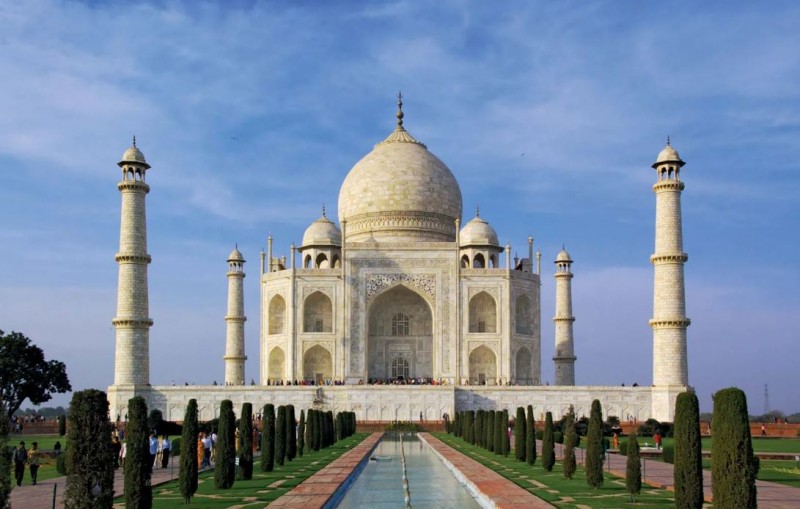
Introduction
The Taj Mahal, an architectural marvel located in Agra, India, is renowned for its breathtaking beauty and intricate craftsmanship. Standing tall as a symbol of love and devotion, this magnificent structure is not only a UNESCO World Heritage Site but also a testament to the creativity and grandeur of the Mughal era. Beyond its architectural splendor, the Taj Mahal holds a captivating secret: it changes color depending on the time of day. In this article, we will delve into the mesmerizing phenomenon that adds another layer of allure to this iconic monument.
1. The Origin of the Taj Mahal
Commissioned by the Mughal emperor Shah Jahan in the 17th century, the Taj Mahal was built as a mausoleum to honor his beloved wife, Mumtaz Mahal, who passed away during childbirth. It stands as an eternal tribute to their love story and remains one of the most recognizable structures in the world.
2. Construction and Design
Designed by the renowned architect Ustad Ahmad Lahauri, the Taj Mahal exhibits a fusion of Persian, Islamic, and Indian architectural styles. Its symmetrical layout and meticulous detailing showcase the pinnacle of Mughal craftsmanship. The central structure, topped by a large dome, is surrounded by four minarets, intricately carved marble screens, and lush gardens, creating a harmonious composition.
3. The Changing Colors of the Taj Mahal
One of the most captivating aspects of the Taj Mahal is its ability to change colors throughout the day. From the soft hues of dawn to the majestic silver serenade of the nighttime, the monument transforms, casting an enchanting spell on its beholders.
4. Dawn: Soft Hues of Pink and Orange
As the first light of the day emerges, the Taj Mahal reflects a delicate palette of pink and orange. The rising sun's rays bathe the pristine marble surface, creating an ethereal ambiance that captivates visitors.
5. Morning: Radiant White Elegance
As the morning progresses, the Taj Mahal reveals its purest form. Bathed in sunlight, its white marble radiates a sense of serenity and purity. The brilliance of its architecture becomes even more pronounced, leaving visitors in awe of its grandeur.
6. Midday: Glistening Marble Under the Sun
When the sun reaches its zenith, the Taj Mahal's marble dazzles under its intense rays. The play of light and shadow accentuates the intricate details of the carvings and inlays, making the monument appear even more resplendent.
7. Evening: A Golden Glow
As the day transitions into evening, the Taj Mahal takes on a golden hue. The setting sun casts a warm glow, enveloping the monument in a magical radiance. This transformative moment adds a sense of mystique and romance to the already captivating structure.
8. Twilight: A Symphony of Colors
During twilight, the Taj Mahal undergoes a mesmerizing transformation. The interplay between the fading daylight and the emerging night sky creates a symphony of colors. Shades of purple, blue, and gray intermingle, casting an enchanting aura over the monument.
9. Nighttime: Majestic Silver Serenade
Under the moonlight, the Taj Mahal dons an ethereal silver sheen. Bathed in a gentle glow, it emanates a sense of tranquility and grandeur. The moonlit backdrop adds an element of magic, creating an unforgettable sight.
10. Factors Influencing Color Changes
Several factors contribute to the Taj Mahal's remarkable color variations. The position of the sun, atmospheric conditions, and the reflective properties of the marble all play a role in the monument's mesmerizing transformation throughout the day.
11. Scientific Explanation
The changing colors of the Taj Mahal can be attributed to the phenomenon known as "scattering of light." The composition of the marble and its reflective properties interact with the sun's rays, causing the varying colors that captivate observers.
12. The Taj Mahal's Cultural Significance
Beyond its captivating beauty, the Taj Mahal holds immense cultural significance. It stands as an architectural masterpiece, representing the rich heritage of the Mughal dynasty and serving as a symbol of eternal love. Its cultural importance attracts millions of visitors from around the globe each year.
13. Preservation and Conservation Efforts
To ensure the Taj Mahal's longevity, preservation and conservation efforts are crucial. The monument faces threats such as pollution, environmental changes, and human impact. Various measures have been implemented to protect this iconic structure and maintain its splendor for generations to come.
14. Impact on Tourism
The Taj Mahal's ability to change colors throughout the day enhances its allure as a tourist attraction. Visitors are drawn to the enchanting experience of witnessing the monument's mesmerizing transformation, making it a must-visit destination for travelers worldwide.
15. Conclusion
The Taj Mahal's ever-changing colors add an extra layer of wonder to its already awe-inspiring architecture. From the soft hues of dawn to the majestic silver serenade of the nighttime, each moment offers a unique spectacle. The interplay between light, time, and the monument's exquisite design creates an enchanting experience for all who have the privilege of beholding its splendor.
Discovering the Top 10 Museums and Galleries around the Globe
France : Famous Travel Destination
Monuments in India: These beautiful buildings in India are the gift of the Mughals